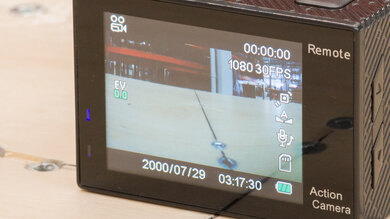The AKASO Brave 4 is a portable action camera. The camera is incredibly small and lightweight, and it comes with a wide array of accessories in the box. While it's advertised as a 4k video camera, its "4k" video setting outputs 2880 × 2160 resolution video, which is disappointing. Its FHD video quality is also poor, especially in low light. That said, it does a fantastic job of smoothing out camera shake in FHD. It also has a great battery life, though this can vary with real-world conditions and usage habits. It's waterproof as long as it's in the included protective case, which adds a bit of bulk but makes it feel more rugged. Otherwise, it feels somewhat flimsy, with cheap materials.
Our Verdict
The AKASO Brave 4 is a poor choice for travel photography. While it's very portable and easy to pack in a bag, its image quality is terrible, and it's intended for action video rather than any photography. The built-in lens has a fixed wide-angle focal length, creating a noticeable fisheye effect, and a fixed aperture. You also can't manually adjust its shutter speed. It also lacks an autofocus system and feels cheaply made, although it does have a long-lasting battery. That said, battery performance can vary drastically with settings and usage habits.
-
Incredibly portable.
-
Great battery life.
-
Poor image quality.
-
Can't adjust shutter speed manually.
-
Fixed aperture and focal length.
-
No autofocus system.
The AKASO Brave 4 is bad for landscape photography, as it isn't meant for this use. Image quality is terrible, with few ISO options and a very limited dynamic range. Its aperture and focal length are fixed, and you can't manually adjust shutter speed, resulting in very little flexibility for landscape photography. It also lacks an autofocus system.
The AKASO Brave 4 is a bad choice for sport and wildlife photography since it's not intended for this use. It doesn't have a manually adjustable shutter speed, and its aperture and focal length are fixed to a wide-angle field of view. Its continuous shooting mode is also extremely limited, and it can only shoot at a slow 2 fps with a very small buffer. Finally, it lacks an autofocus system and feels cheaply built.
The AKASO Brave 4 is poor for vlogging. While it's very portable, it feels poorly built, and switching out mounts and accessories can be cumbersome. You also can't use its front-facing screen for playback or live view, and it doesn't have an autofocus feature. It's advertised to shoot 4k video, but it can't record true 4k video. Its FHD video quality is also poor. On the upside, it does a fantastic job of smoothing out camera shake in FHD.
-
Incredibly portable.
-
Great battery life.
-
Fantastic FHD video stabilization.
-
Bad FHD video quality.
-
Doesn't support native 4k video.
-
Fixed aperture and focal length.
-
No autofocus system.
The AKASO Brave 4 is bad for studio video. It can't record native 4k video, and its FHD video quality is bad. It has a poorly designed menu system that's a bit cumbersome to navigate, and it lacks inputs and outputs, with no headphone or microphone jack.
-
Incredibly portable.
-
Great battery life.
-
Fantastic FHD video stabilization.
-
Bad FHD video quality.
-
Doesn't support native 4k video.
-
Fixed aperture and focal length.
-
No autofocus system.
The AKASO Brave 4 is a disappointing action video camera. Despite being advertised as a 4k camera, it can't record 4k video. Its video quality in FHD is also poor, and its frame rate options are limited since it can only record FHD video at 30 fps or 60 fps. On the upside, it's incredibly lightweight and portable. It also does a fantastic job smoothing out camera shake in FHD, and it's waterproof, but only with the included protective case, though we don't currently test for this.
-
Incredibly portable.
-
Great battery life.
-
Fantastic FHD video stabilization.
-
Bad FHD video quality.
-
Doesn't support native 4k video.
-
Only waterproof with protective case.
-
Limited frame rate options.
- 5.3 Travel Photography
- 6.0 Landscape Photography
- 3.7 Sport & Wildlife Photography
- 3.9 Vlogging
- 3.2 Studio Video
- 5.4 Action Video
Changelog
- Updated Dec 21, 2022: Converted to Test Bench 0.12.
- Updated Dec 20, 2022: Converted to Test Bench 0.11.
- Updated Oct 03, 2022: Converted to Test Bench 0.10.
- Updated Sep 02, 2022: Converted to Test Bench 0.9.
- Updated May 18, 2022: Converted to Test Bench 0.8.
Check Price
Differences Between Sizes And Variants
The AKASO Brave 4 comes in one color variant: Black. You can see our unit's label here.
If you come across another variant or your AKASO Brave 4 doesn't correspond to our review, let us know, and we'll update the review.
Compared To Other Cameras
The AKASO EK7000 and AKASO Brave 4 are similar cheap action cameras. The EK7000 is a bit better overall since it can record in true 4k resolution and offers more frame rate options.
Test Results
Note: With the protective case equipped, the camera is slightly less portable, measuring:
- Height: 2.8" (7.1 cm)
- Width: 2.8" (7.1 cm)
- Depth: 1.6" (4.1 cm)
- Volume: 12.6 in³ (206.7 cm³)
- Weight: 0.24 lbs (0.11 kg)
- Weight With Lens: 0.24 lbs (0.11 kg)
- Materials feel flimsy, with cheap-feeling hard plastic that scratches easily
- Plastic battery cover may be easily lost since it isn't attached to the camera
- No cover for inputs and outputs
- Buttons feel clicky but somewhat loose-fitting
- Rear screen and plastic cover feel flimsy
- With the included protective case, the camera feels more sturdy and secure
Note: With the included protective case, the camera is advertised to be waterproof up to 100 feet, though we don't currently test this.
- Intended to be mounted and used as an action camera, but it can also be used handheld to take photos/videos if desired
- No touchscreen functionality
- Settings can be adjusted using the arrow buttons on the side and the 'OK' button on the top of the camera, which also acts as the shutter button
- Switching out accessories and mounts can be cumbersome
- Plastic finish makes it somewhat slippery
Note: This camera has a small front-facing screen that can only display the camera mode, remaining battery life, and memory card space.
- Menu is a bit sluggish and can only be accessed by cycling through the camera modes
- No distinction between photo and video settings
- You can only navigate the menu using the two arrow buttons on the side of the camera, and there's only one menu tab, so it takes a while to scroll through to find the setting you're looking for
- Design is misleading, with left and right arrows shown on the menu, despite only being navigable using the physical up and down arrows on the camera
- No guide mode to provide additional information about settings
Note: When charging via USB over a computer, you can only use the camera as a webcam and not take photos or videos. Also, the camera splits up long recordings into sequential clips of 3 minutes and 1 second each.
Note: This camera only has a single burst mode that you can set to take bursts of 3, 5, or 10 images, and it shoots at a speed of approximately 2 fps.
Note: We weren't able to run our image stabilization test properly because this camera doesn't have a manually adjustable shutter speed.
Note: This camera doesn't shoot in RAW format.
Note: This camera is advertised as a 4k camera, but it's not actually capable of shooting native 4k video. When using its '4k' setting, it can only produce 2880 x 2160 resolution video with a 4:3 aspect ratio.
Note: According to AKASO, the camera doesn't record sound when in its protective case; however, we don't currently test this.
Note: This camera is advertised as a 4k camera, but it can only produce 2880 x 2160 resolution video with a 4:3 aspect ratio. When playing back the camera's advertised "4k" video, VLC and other media players will scale it up to a 16:9 aspect ratio. However, when processing the same video file in a video editor like DaVinci Resolve, the video is squished into a 4:3 aspect ratio, as seen here. You can see a rescaled 16:9 frame here.
Note: This camera doesn't have adjustable bit rate settings.
Comments
AKASO Brave 4: Main Discussion
Let us know why you want us to review the product here, or encourage others to vote for this product.


























































